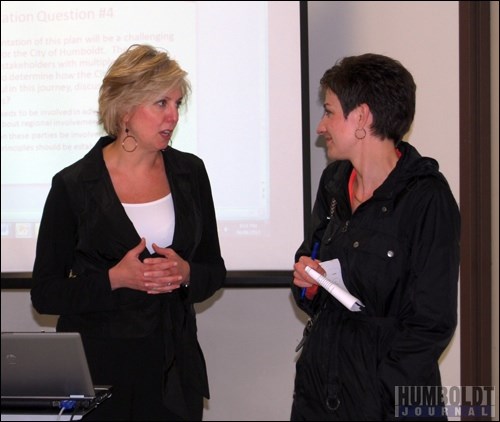A diverse cross-section of Humboldt's community attended a facility development meeting at the Uniplex on June 6.
About 30 people attended the meeting to discuss the future development of Centennial Park. The proposed project includes a theatre, a second sheet of ice, a field house, ball diamonds, a soccer/football field, and a trail around the park's circumference.
"We're trying to look ahead at what the future might hold," said Mayor Malcolm Eaton, who began the meeting with a welcome speech. "We've been finding it a struggle sometimes to try and figure out what this community's going to look like five or 10 or 15 years from now. But we have to do that, because what we're investing in is for the next five or 10 or 15 years.
"This evening we're here to discuss the cultural and recreational infrastructure of the community," the mayor continued. "With the recent addition of the high school and regional college, we needed a master plan for the Centennial Park grounds. That was developed, and that's what we have before us this evening. City council is looking for direction from you folks and the community at large to support and assist us to move forward with the next phase."
People from the arts community, from different sports organizations, independent business owners in the city, as well as employees of the city's Community and Leisure Services attended the meeting. Val Sluth, a strategy consultant from the Praxis Group in Calgary, was invited to facilitate the meeting.
"The long-term goal of what we're doing is really to create a 10-year facility development plan, which is the implementation of your Centennial Park vision," Sluth said to the community members present at the meeting. "Ultimately, what you do want is this 10-year plan. For tonight, what we're trying to do is to determine to what degree the community is buying in. We want to hear your perspective on that."
Sluth had the people work together in small groups to address the questions she put forth for discussion. For example, what criteria should be used to determine which elements of the City's master plan should take precedence over others? Then she asked each group to rank these elements into three stages: short-term, mid-term and long-term goals. Finally, each group was asked to think about what parties should be involved in an advisory capacity, whether or not there should be regional involvement, and if so, under what principles?
Factors that each group took into consideration when making these decisions included replacing what is being removed (such as the Sunderland Theatre), the prospect of hosting future events along with the economic spin-off for the city, the complexity and cost of the construction, and the city's financial situation for being able to construct these elements without cutting corners.
While initially, the element of the master plan chosen as the number one priority varied from group to group, eventually a common thread emerged when it came down to determining which facility should be ear-marked for the short-term goal. All seven groups agreed that the greenspace, or ball diamonds and football/soccer field, was the part of the master plan that should be completed on a short-term basis.
Each group also agreed that regional involvement would be welcome if they were willing to help pay for the cost, whether it be through taxes or some other financial means. Lastly, an advisory committee should be formed and attached to the project to interact with city council toward establishing a plan that is clearly defined with a timetable in place.
At the end of the meeting, Sluth said how impressed she was with the way the meeting had gone, and complimented the mayor and his council on their approach in dealing with the city's anticipated growth.
"It's been exciting to be with you here tonight to talk about this amazing plan," she said. "You have 10 years, and you can't do it all at once, so we want to do it in parts. Every community does it that way, but not every community does it in such a planful way. You're doing it right."




